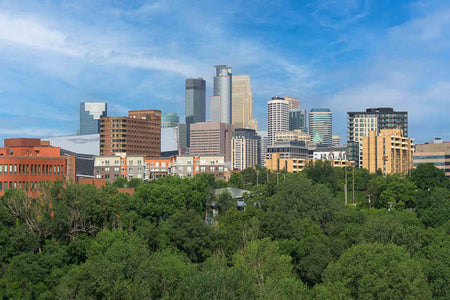Montana's breathtaking landscapes and vast open spaces are a sight to behold, but they come with a unique and challenging allergy season. As the seasons change, so do the allergens in the air, causing discomfort for many residents. To help you manage this issue, we've compiled a list of the causes of allergies in Montana, the most common allergens and tips for managing allergy symptoms.
What Causes Allergies in Montana?
Allergies occur when the immune system overreacts to substances that are typically harmless. In Montana, pollen, mold spores, and dust mites are the primary culprits. These allergens are particularly prevalent during the spring and fall seasons, when plants release their pollen and mold spores become more abundant.
Common Allergies in Montana
Pollen from trees, grasses, and weeds is a significant trigger for allergies in Montana. Sagebrush, ragweed, and various grasses are among the most common allergenic plants. Mold spores thrive in damp environments, making them prevalent in areas with high humidity or after rainfall. Dust mites, microscopic creatures that live in bedding, upholstery, and carpets, can also trigger allergies.
Montana Allergy Season: What to Expect Year-Round
Montana's changing seasons bring with them a variety of allergens that can cause discomfort for many residents. Here's what you can expect throughout the year:
Spring
As Montana's snow melts and temperatures rise, spring ushers in new life and an increase in pollen levels. Trees such as cottonwood, birch, and pine release their pollen into the air, leading to allergic reactions for many individuals. Grass pollen is also a prevalent allergen during the spring months.
Summer
Summer is a time for outdoor activities and soaking up the sun, but it can also be troublesome for those suffering from allergies. Grass and weed pollen, including ragweed, sagebrush and pigweed, are some of the most common culprits during this season. Mold spores also thrive in the warm and humid conditions, adding to allergy symptoms.
Related: Summer Allergies Guide
Fall
Autumn in Montana brings with it a new set of allergens. Mold spores continue to be problematic, especially in damp places. Ragweed is highly prevalent in the state and releases its pollen until the first frost. Dust mites, another common allergen, can also cause issues as people spend more time indoors with the windows closed and heating systems on.
Related: Fall Allergies Guide
Winter
Even in Montana's cold and snowy winters, indoor allergens can still trigger discomfort for allergy-sufferers. Dust mites, pet dander, and mold spores thrive in warm and humid environments, such as heated homes. Spending more time indoors during the winter months can increase exposure to these allergens, leading to symptoms such as sneezing, coughing, and congestion.
Exploring Montana's Allergies Based on Regions
Allergen prevalence and variety can differ depending on the region in Montana. We have highlighted some examples below:
Western Montana
With its magnificent forests and mountainous terrain, Western Montana is renowned for its natural beauty. However, this region has a high pollen count due to the abundance of trees and grasses, making seasonal allergies a common issue. Ragweed, a well-known allergenic plant, is also present in this area.
Eastern Montana
Compared to the western part of the state, Eastern Montana has a drier climate. While pollen levels may be lower, mold spores can be a significant allergen in this region, especially in areas with water bodies or agricultural activities.
Mountainous Regions
The mountainous regions of Montana, particularly the Rocky Mountains, have their unique set of allergens. Alpine plants and trees, such as juniper and spruce, can trigger allergies in individuals sensitive to their pollen.
Managing Allergy Symptoms
Although it may be impossible to avoid allergens entirely, there are steps you can take to minimize exposure and manage your symptoms:
- Keep Windows Closed. During peak allergy season, keep your windows closed to prevent pollen and mold spores from entering your home.
- Use Air Purifiers. Air purifiers with HEPA filters can help remove allergens from the air inside your home.
- Clean Regularly. Frequently dust and vacuum your home to reduce the presence of dust mites.
- Monitor Pollen Counts. Stay informed about the pollen counts in your area and plan outdoor activities accordingly. Pollen counts are typically highest in the morning and on windy days.
- Wear Protective Clothing. When spending time outdoors, wear sunglasses and a hat to protect your eyes and face from pollen.
- Rinse Your Sinuses. Nasal irrigation with a saline solution can help flush out allergens and relieve congestion.
- Consult a Healthcare Professional. If your allergies are severe or significantly impact your quality of life, consider seeking medical advice. Allergy shots or medication may be recommended.
By taking these precautions, you can minimize the impact of allergies on your daily life and enjoy all that Montana has to offer, even during allergy season. Remember, knowledge is power when it comes to managing allergies, so stay informed and take proactive steps to protect yourself.
Customized Allergy Treatment at Home
Using multiple over-the-counter allergy treatments is not ideal for getting through allergy season in Montana. Skip the drugstore and get a personalized all-in-one allergy treatment from the comfort of your home.
Allermi is a customized allergy nasal spray designed by experienced, board-certified allergists to solve your unique seasonal allergy symptoms. The Allermi formula is backed by science to give you the most effective allergy treatment for your individual allergy symptoms.
The best part? Allermi nasal spray is easy to use and delivered to your door in Montana.









